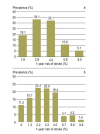Atrial fibrillation: its prevalence and risk factor profile in the German general population
- PMID: 22577476
- PMCID: PMC3349225
- DOI: 10.3238/arztebl.2012.0293
Atrial fibrillation: its prevalence and risk factor profile in the German general population
Abstract
Background: Atrial fibrillation (AF) is an increasingly common problem in primary care, but little is known about its prevalence and the distribution of AF risk factors in the general population.
Methods: We determined the prevalence of AF and the distribution of known AF risk factors among persons participating in the population-based Gutenberg Health Study. To this end, we used interview data about the medical diagnosis of AF and electrocardiograms (ECGs) that were performed for the study in 5000 persons aged 35 to 74. The response rate was 60.4%.
Results: There were 5000 persons in the study sample (age 52.2 ± 11 years; 50.6% were women). The prevalence of AF, weighted for the age and sex distribution of the general population, was 2.5%. AF was found to be more common in older persons, with a more pronounced increase in men: whereas its prevalence was 0.7% in 35- to 44-year-old men, the corresponding figure for the age group 65- to 74 was as high as 10.6%. Twenty five participants (15.5% of AF cases) received their initial diagnosis of AF on the basis of the study ECG. Compared to persons without AF, persons with AF were older and more commonly male, and they had a higher burden of cardiovascular risk factors. 14.3% of persons with AF had none of the well-established risk factors for AF (systolic blood pressure, antihypertensive medication, increased body-mass-index, heart failure). 42.7% of persons with AF were not taking either anticoagulants or platelet inhibitors.
Conclusion: These data indicate that the prevalence of AF in the middle-aged general population is 2.5% overall, and higher in the elderly. AF is thus a significant public health problem, and greater awareness of it is needed.
Figures



References
-
- Miyasaka Y, Barnes ME, Gersh BJ, et al. Secular trends in incidence of atrial fibrillation in Olmsted County, Minnesota, 1980 to 2000, and implications on the projections for future prevalence. Circulation. 2006;114:119–125. - PubMed
-
- Stefansdottir H, Aspelund T, Gudnason V, Arnar DO. Trends in the incidence and prevalence of atrial fibrillation in Iceland and future projections. Europace. 2011;13:1110–1117. - PubMed
-
- Lloyd-Jones DM, Wang TJ, Leip EP, et al. Lifetime risk for development of atrial fibrillation: the Framingham Heart Study. Circulation. 2004;110:1042–1046. - PubMed
-
- Wang TJ, Larson MG, Levy D, et al. Temporal relations of atrial fibrillation and congestive heart failure and their joint influence on mortality: the Framingham Heart Study. Circulation. 2003;107:2920–2925. - PubMed
Publication types
MeSH terms
LinkOut - more resources
Full Text Sources
Other Literature Sources
Medical

